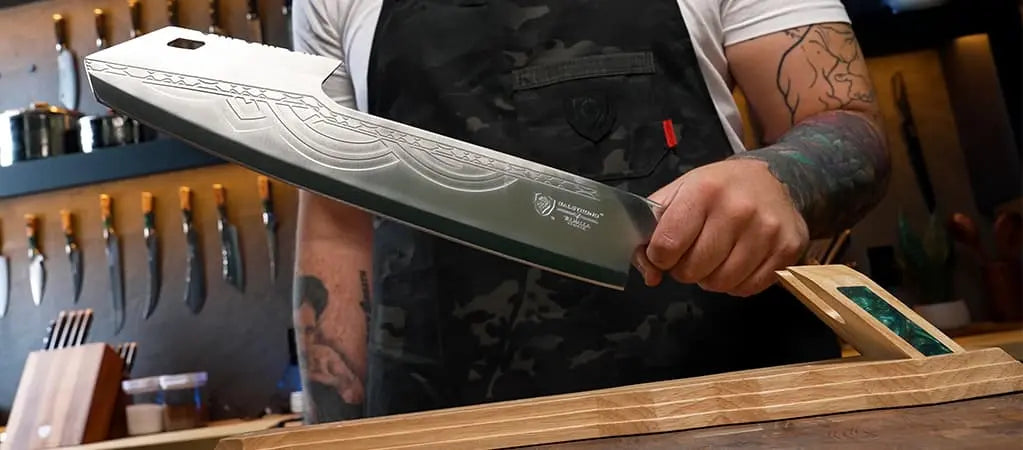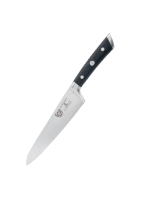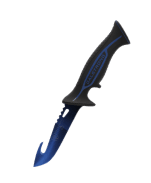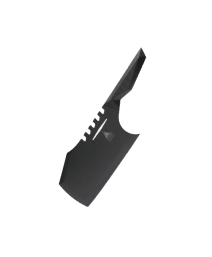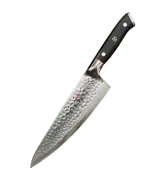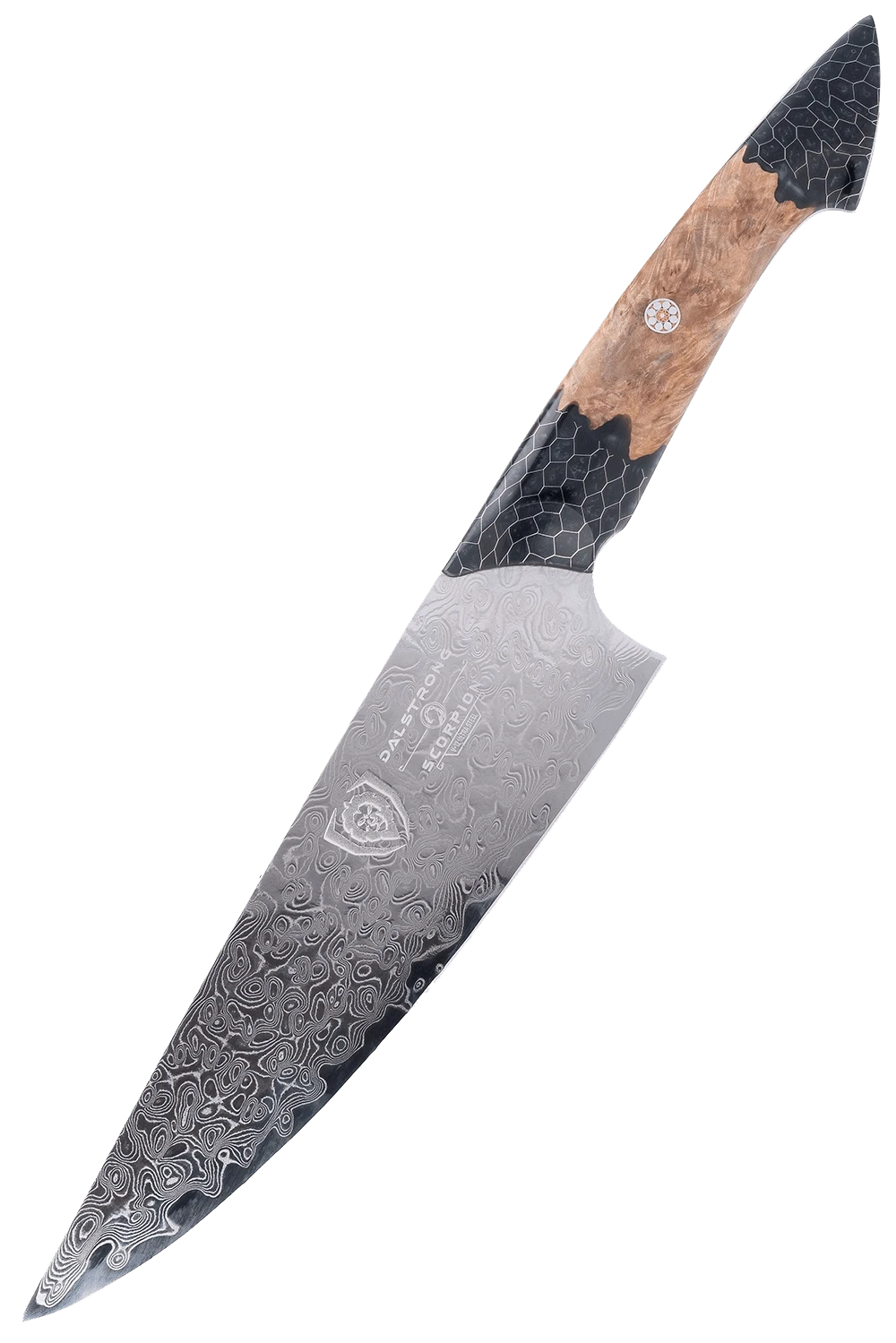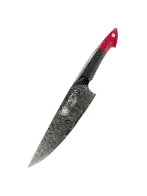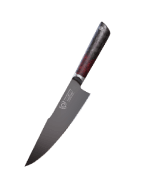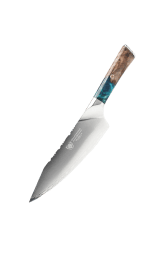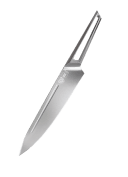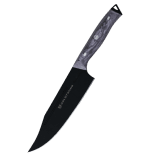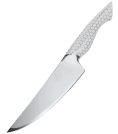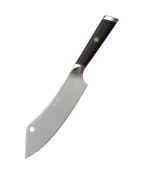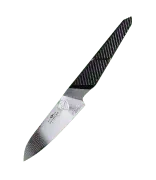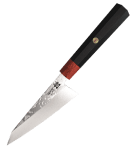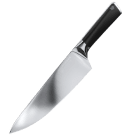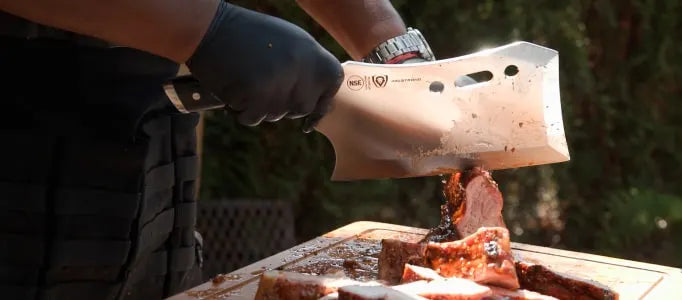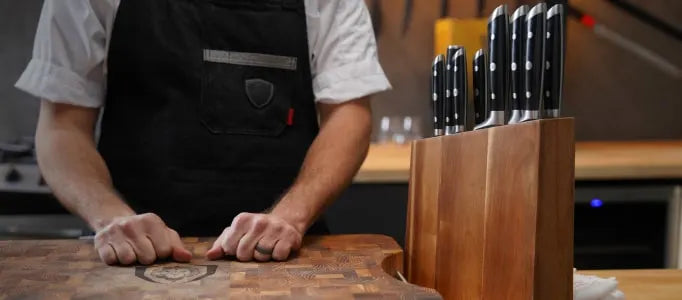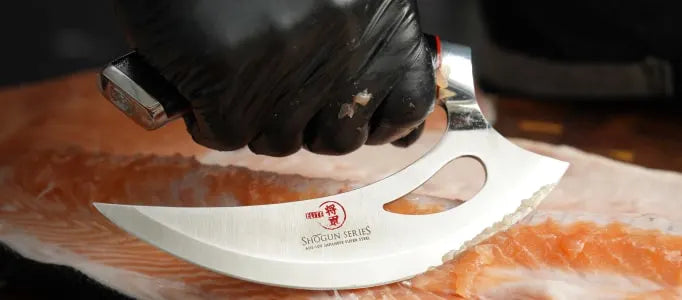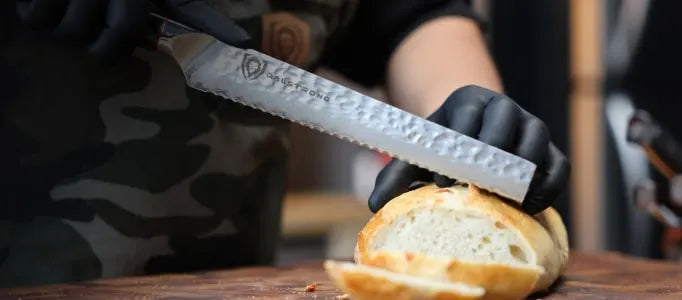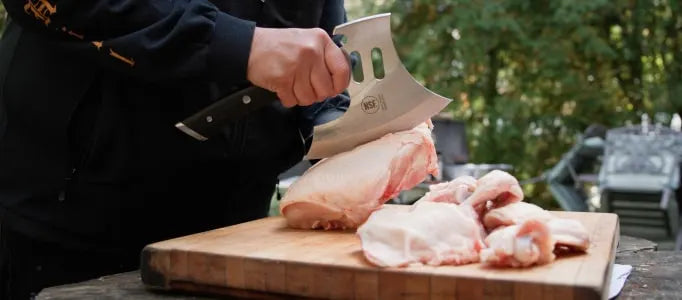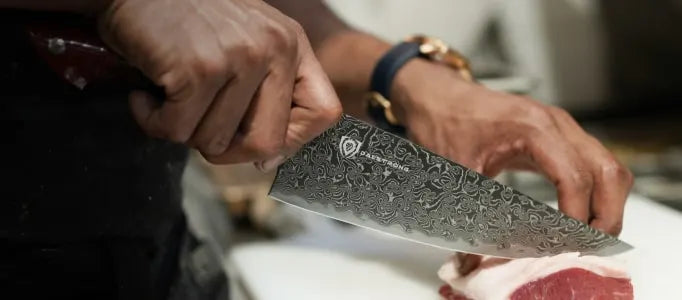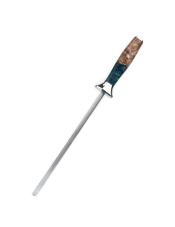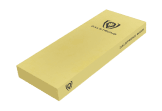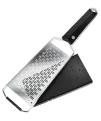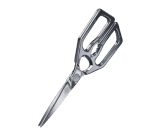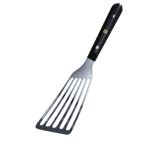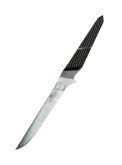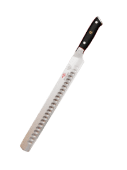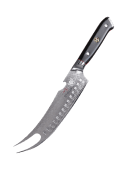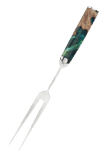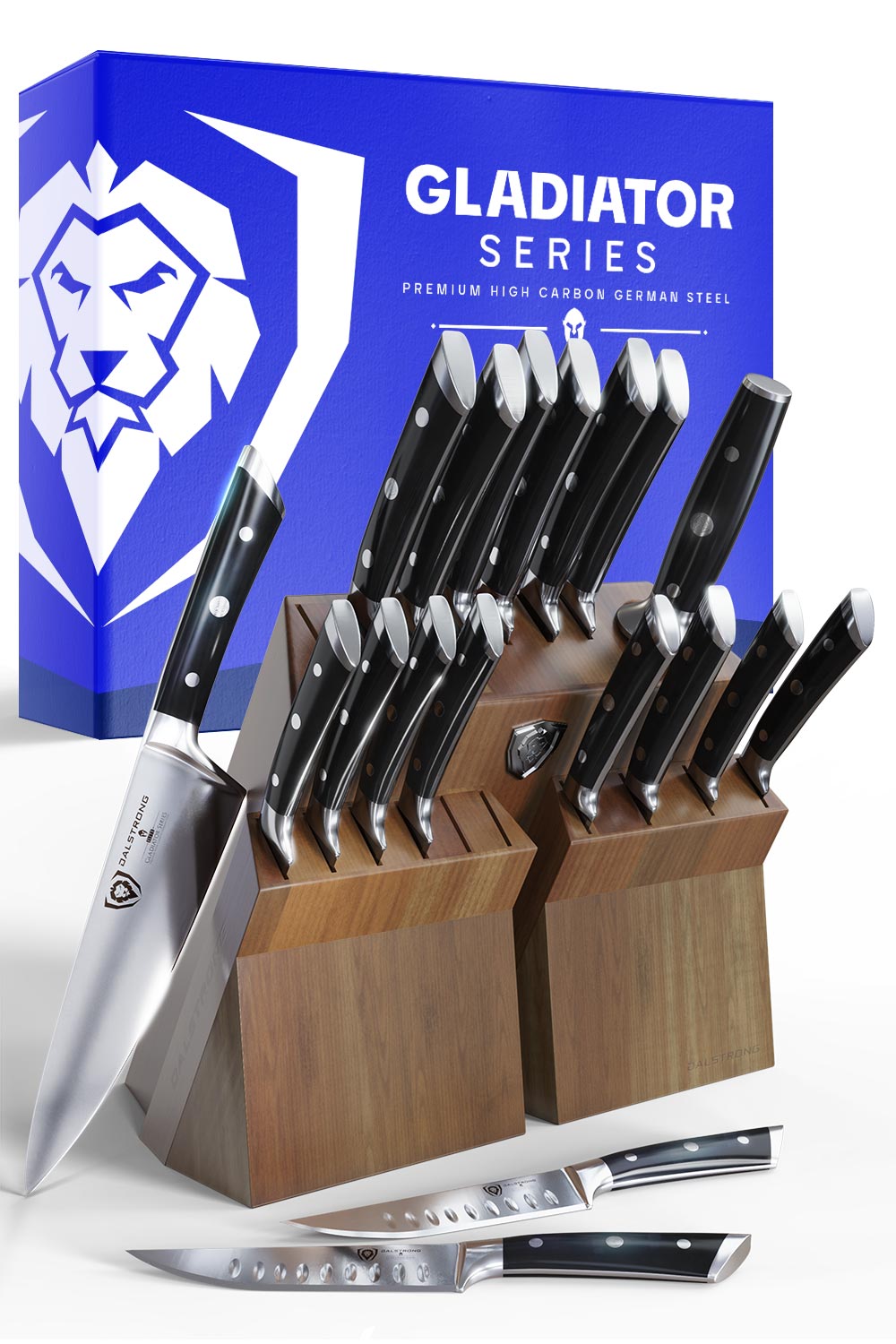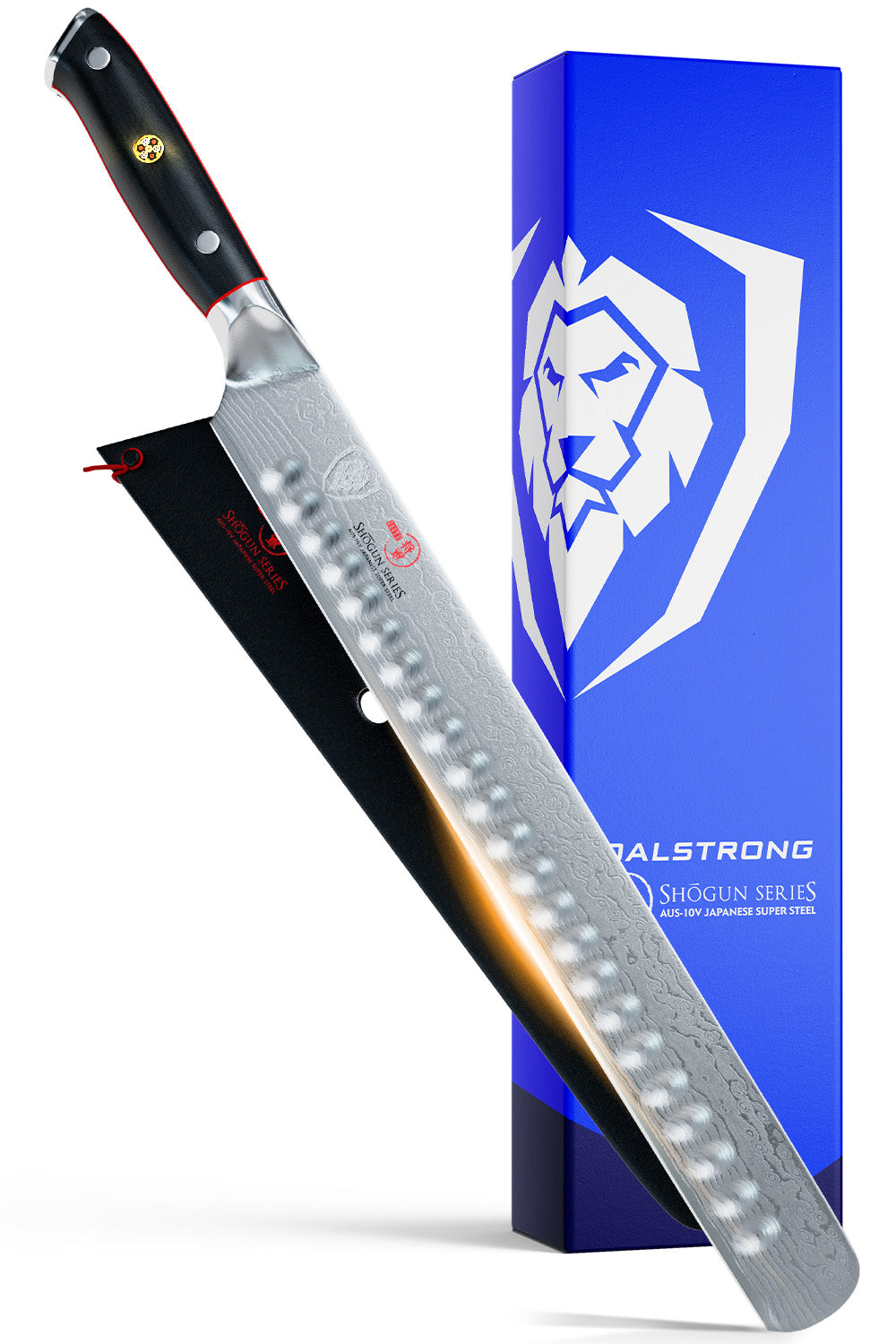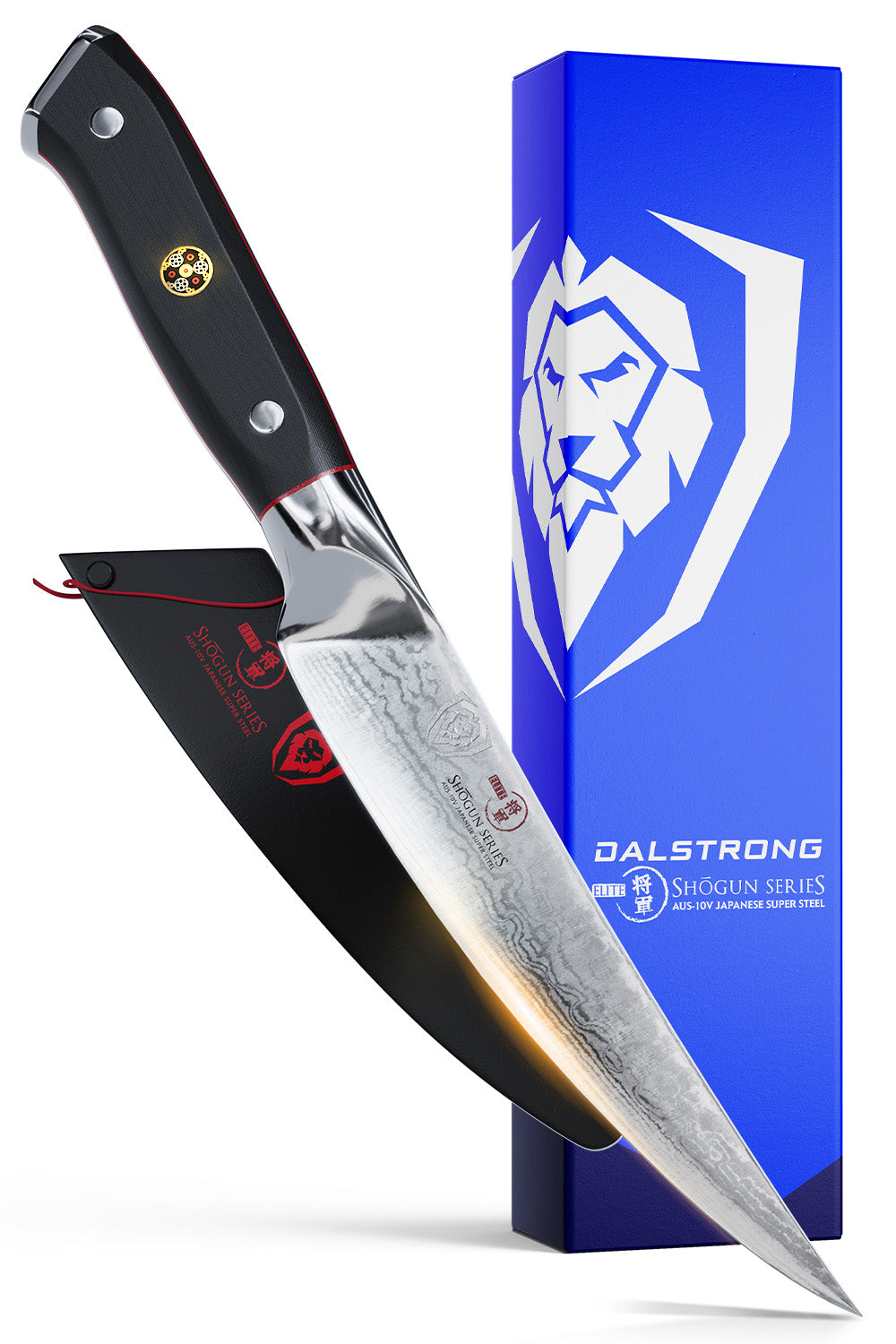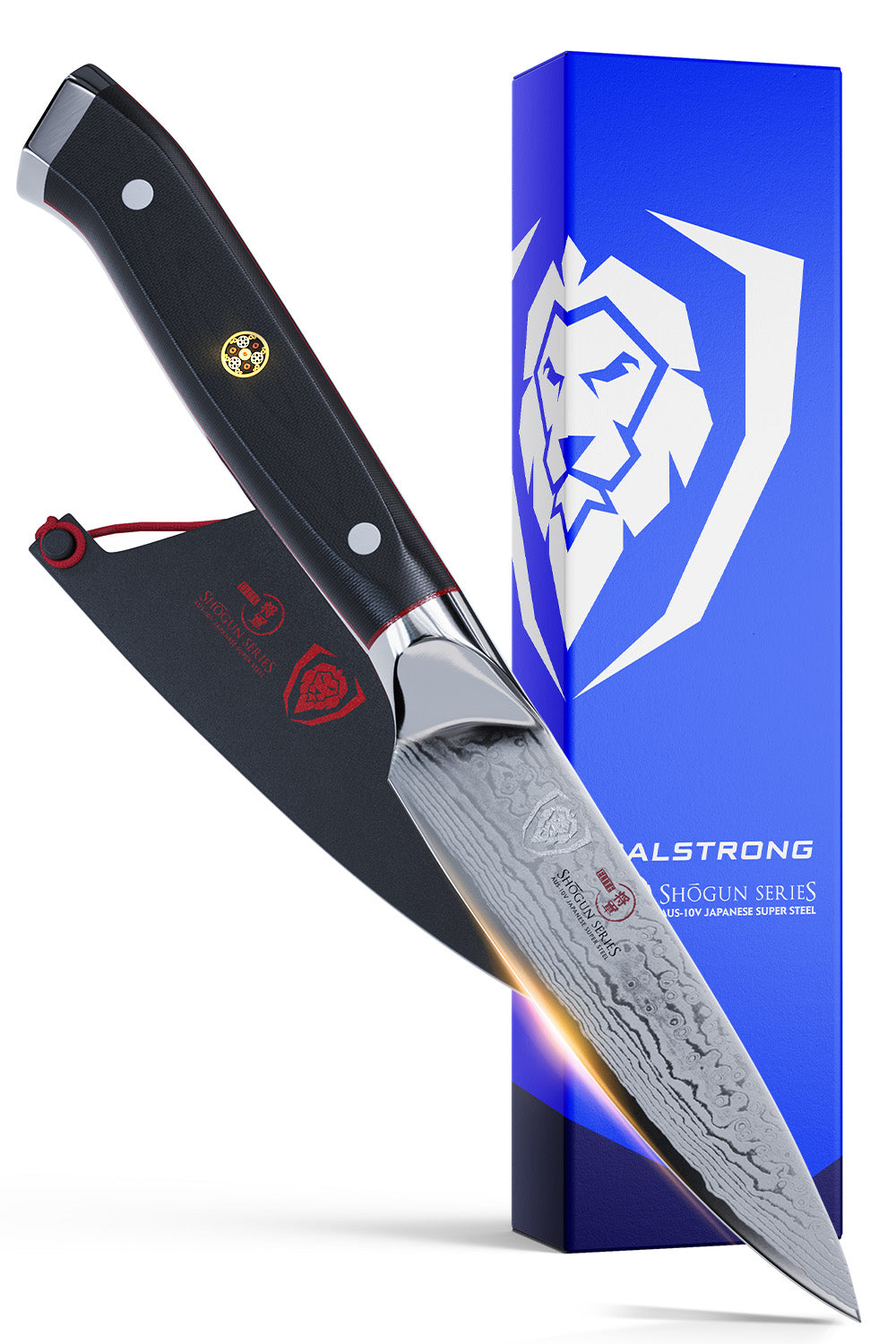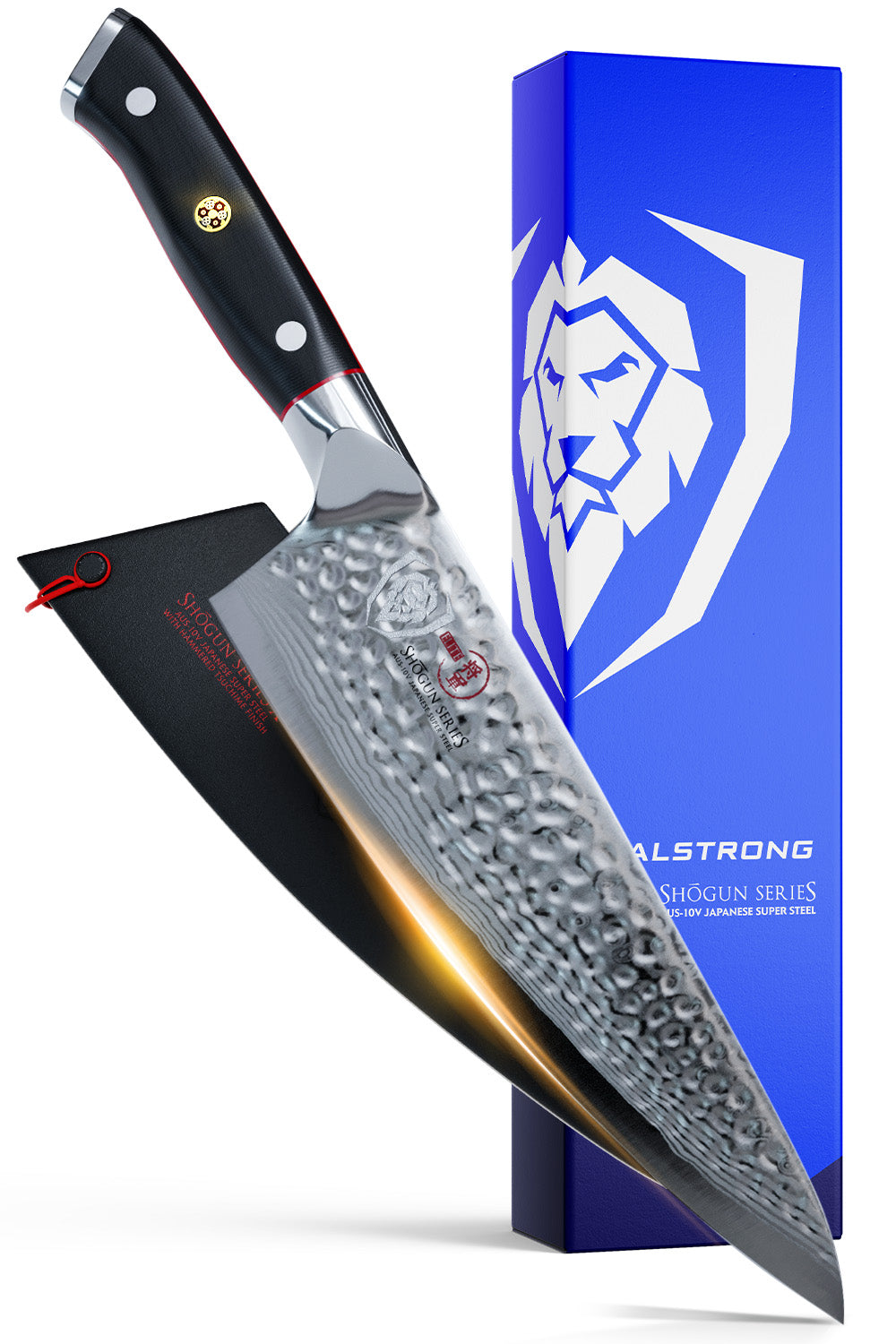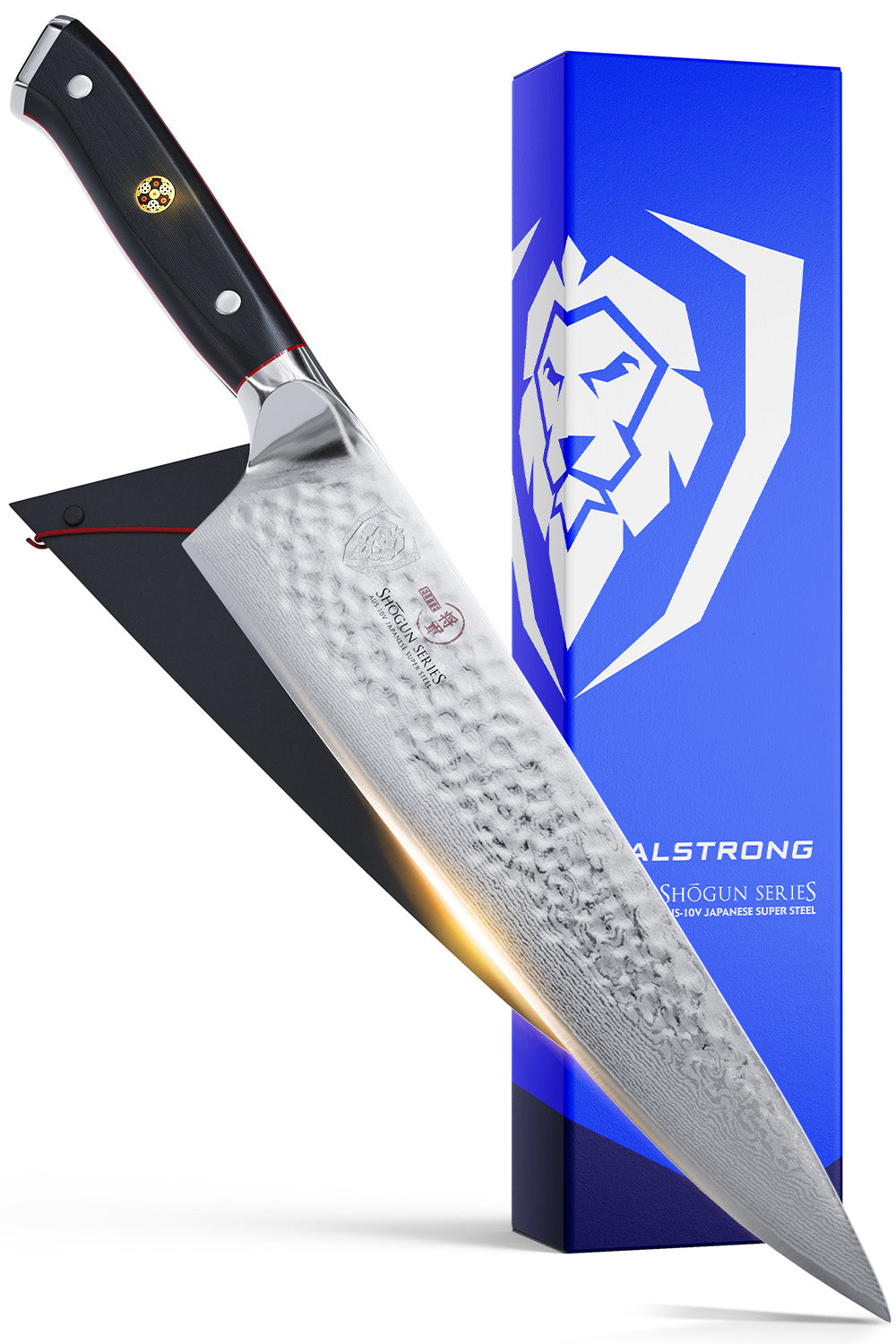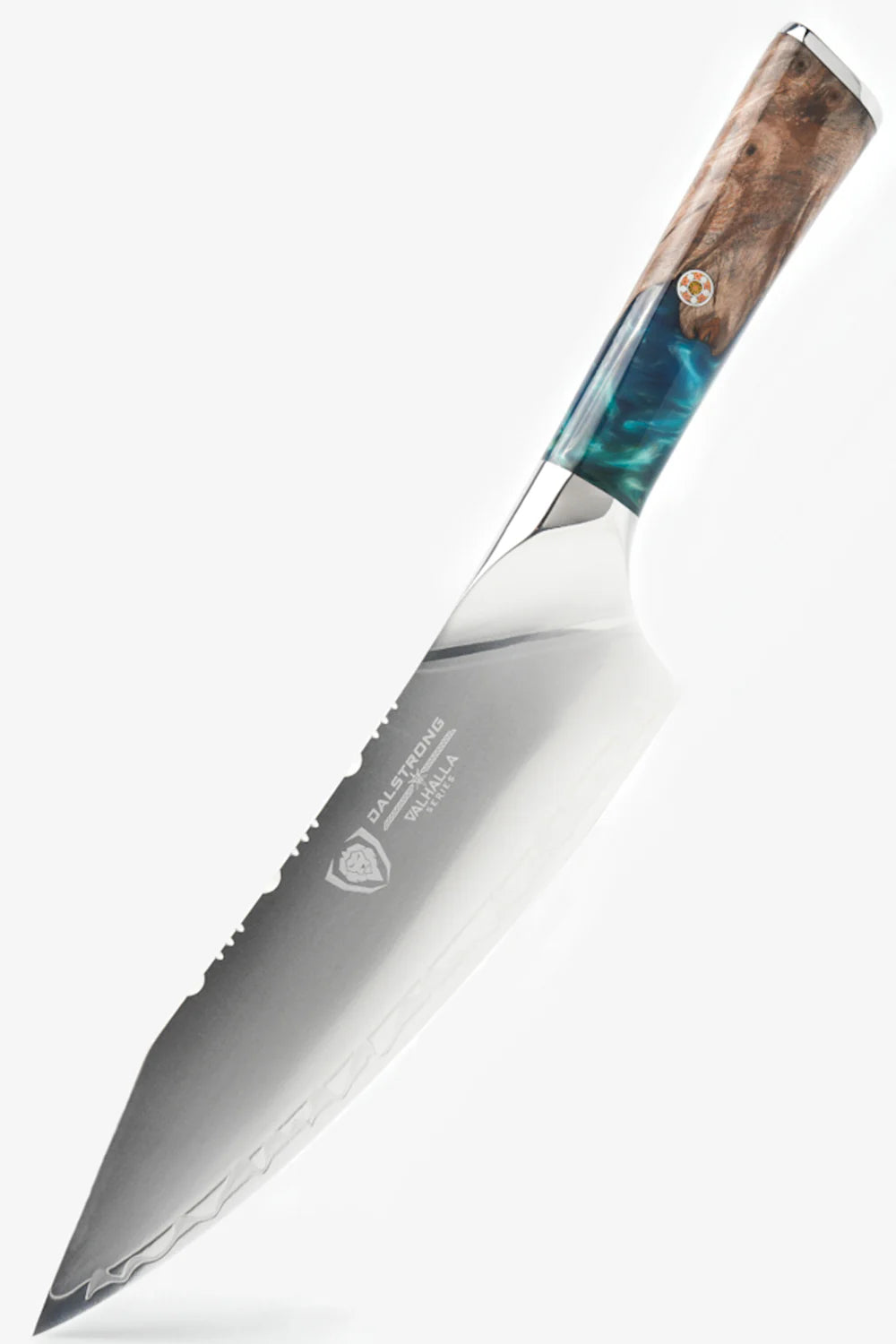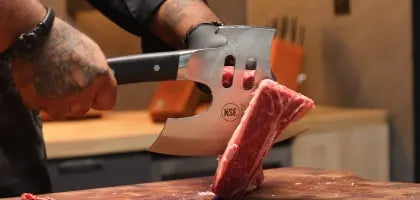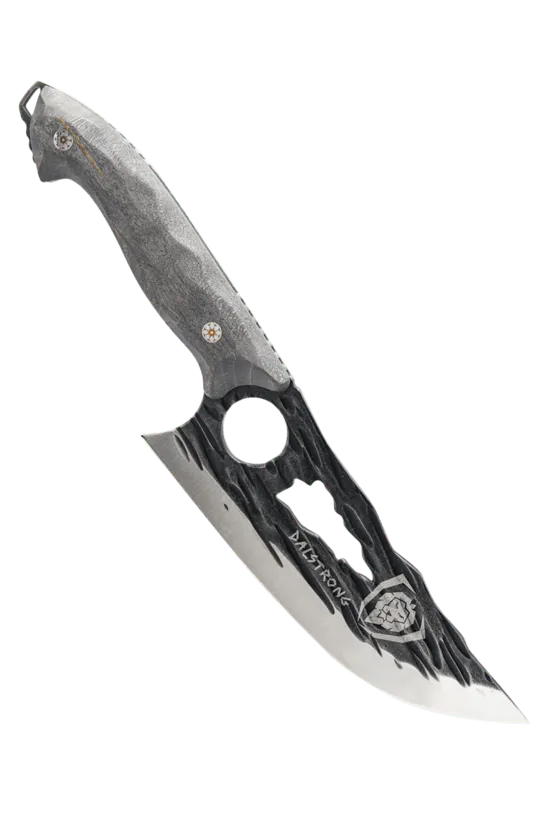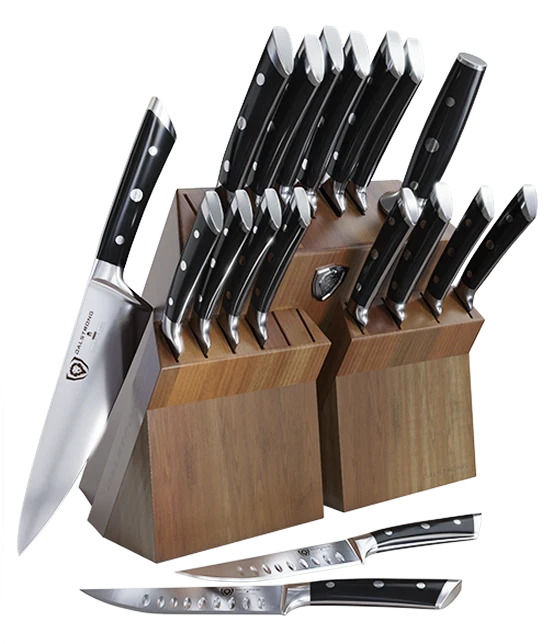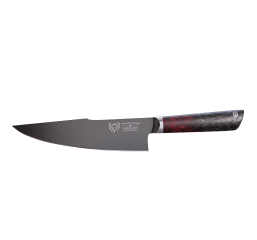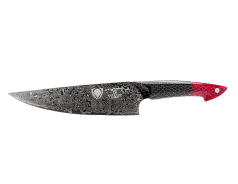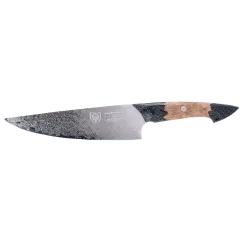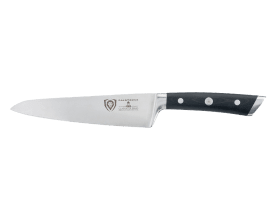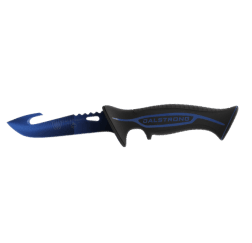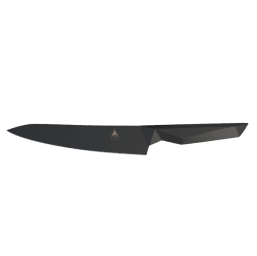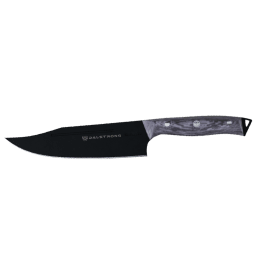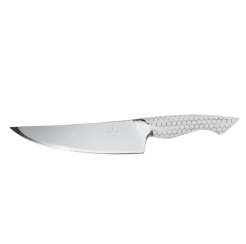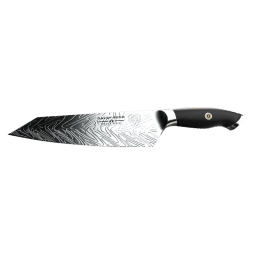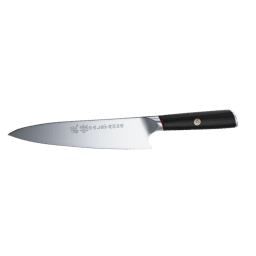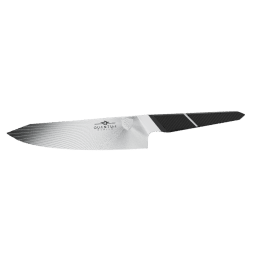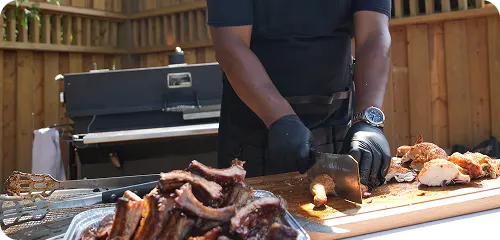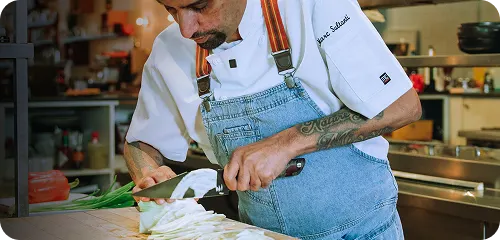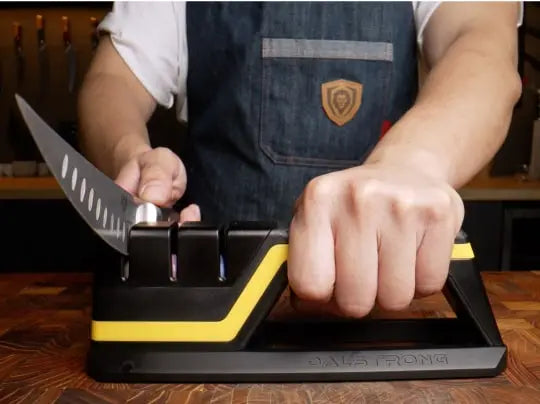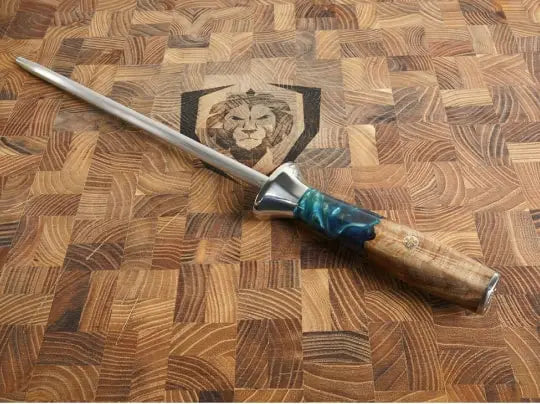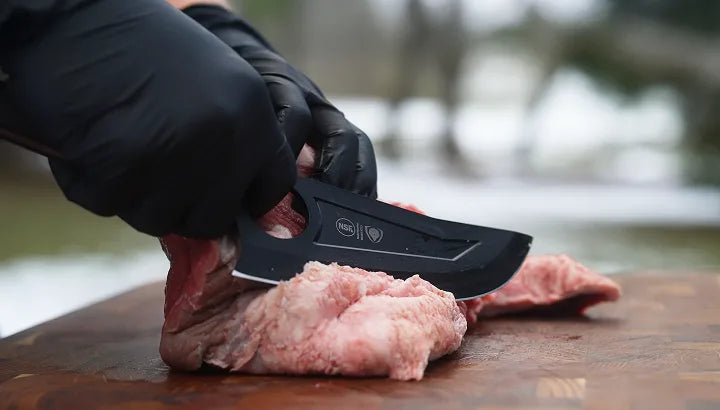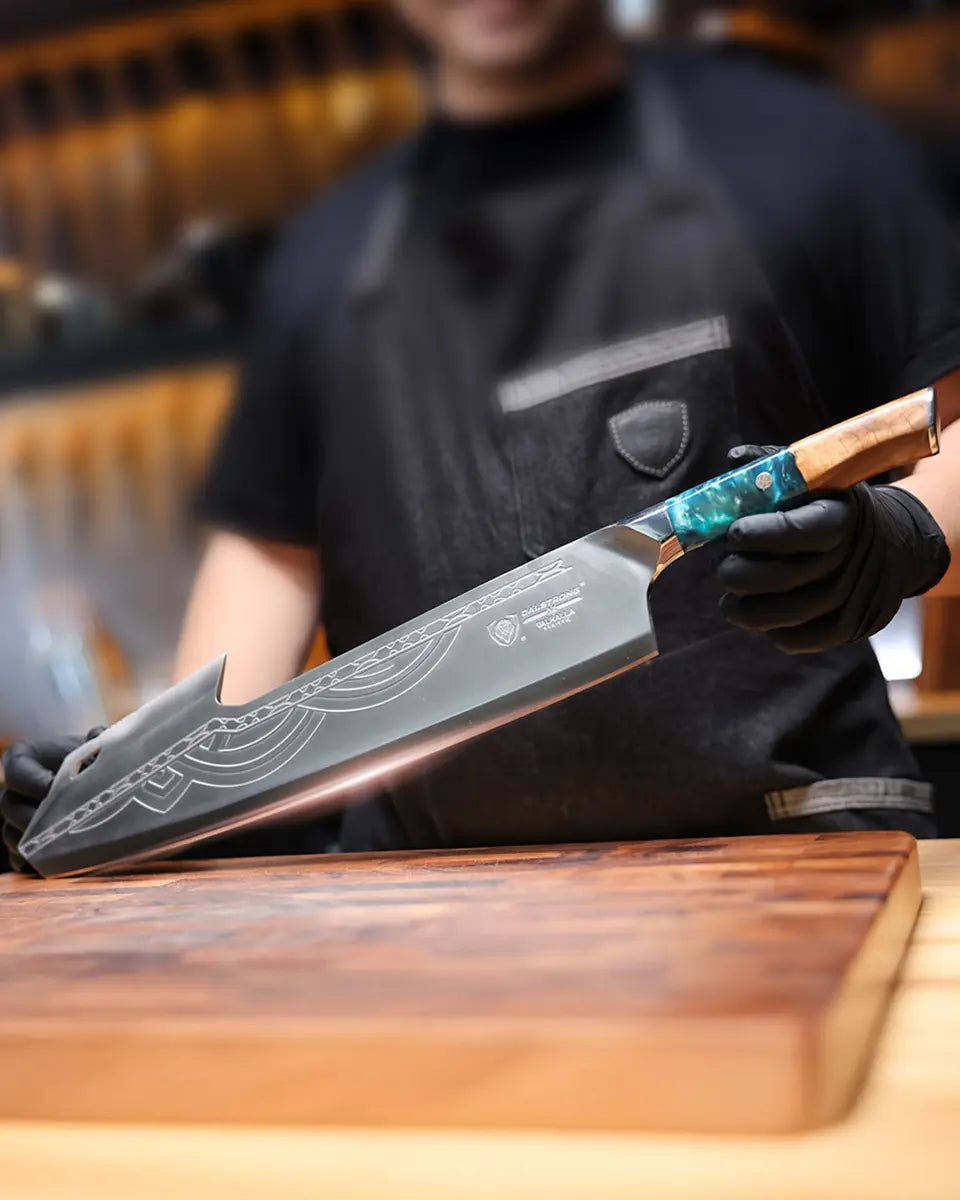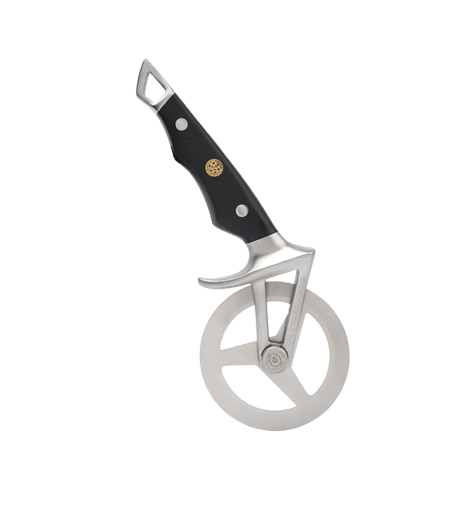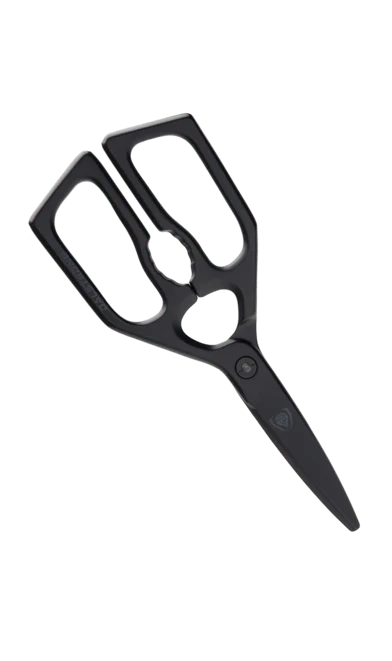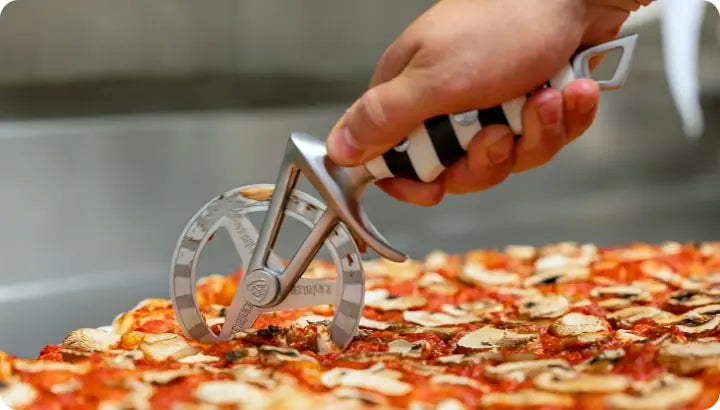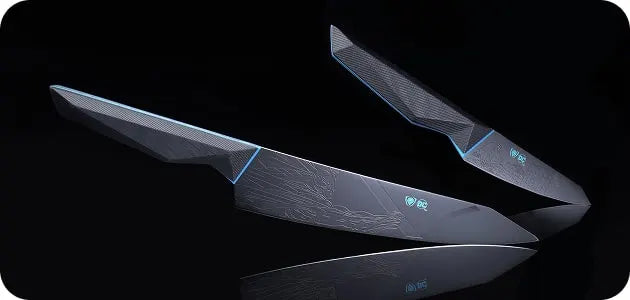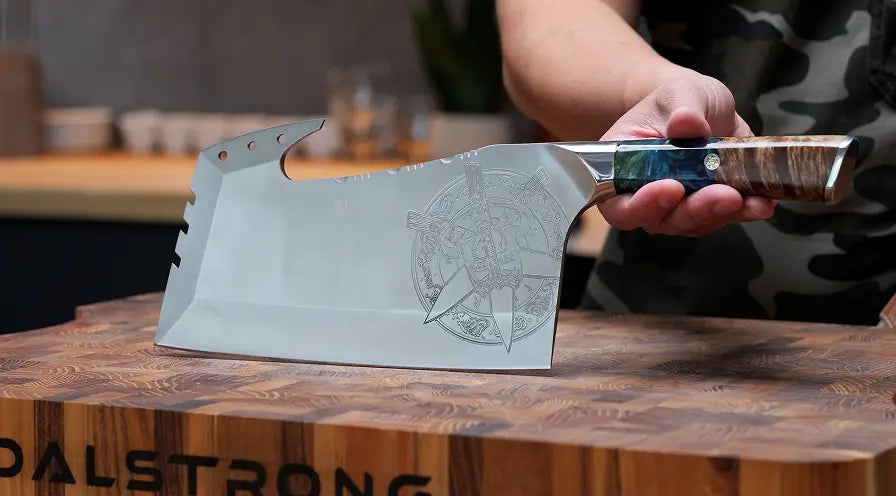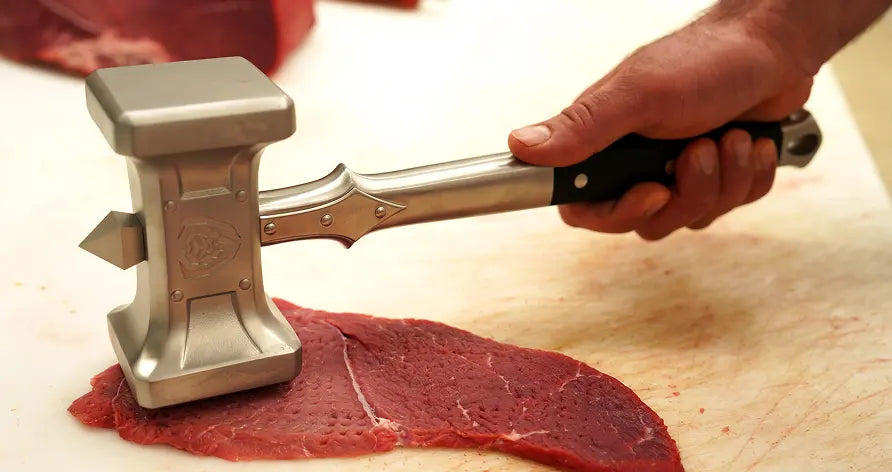9'' Bread Knife | Omega Series | Dalstrong ©
How To Cut A Pineapple
- Slice off the crown and bottom
- Trim out the thick skin
- Remove the eyes with a paring knife
- Remove the fibrous core
- Cut into small pieces
9'' Bread Knife | Phantom Series | Dalstrong ©
Content Table :
- Let’s Talk About Pineapples
- How To Cut A Pineapple
- Best Knives For Cutting Pineapples
- Top Ten Little-Known Facts About Pineapples
- Frequently Asked Questions About Pineapples
1. Let’s Talk About Pineapples

I really, really love pineapple.
And I’m not alone in this; this decidedly weird-looking but utterly delicious fruit has been the favorite of European royalty from way back when Christopher Columbus first transported it from South America. It’s sweet, it’s tart, it has an incredibly pleasing bite to it… it’s just about everything you want in a tropical fruit. Oh, and it can tenderize your steak. More on that later.
Honestly, there are few things better than juicy pineapple recipes. Having some slices of fresh pineapple on a hot summer day is one of my favorite things in the world. And if you didn’t know, grilled pineapple can also be used as the fresh fruit base for hot sauce. It works surprisingly well
And it’s so versatile! It can be used on all manner of dishes. From the ever-controversial pineapple pizza (I contend that it is 100% a valid topping that works deliciously with cheese) to fruit salad, pineapple salsa, to tacos al pastor (a wonderful type of taco made with spit-grilled pork and chunks of grilled pineapple) to desserts like pineapple upside down cake, and the always delicious pineapple juice. There are many, many uses to this marvellous fruit.
2. How To Cut A Pineapple
8.5'' Kiritsuke Knife | Shogun Series | Dalstrong ©
I know. The first time you’re faced with the thick, prickly skin of a pineapple, it’s a bit intimidating. More than a fruit one can easily slice, it more closely resembles some kind of sci-fi space rock. It seems like something one would need special equipment to pierce through, or know some sort of special knife skills to conquer. It’s actually super simple!
There are several theories about how to cut a pineapple, but sometimes sticking with the tried and true is the best way to go. Below we will detail the easiest way to cut pineapple, as well as offer some handy tools you can use to make things even easier for yourself.
Get your cutting board and knife ready, because it’s time to get slicing.
Step one: Slice off the crown and the bottom
Place the fresh pineapple on the cutting board and lay it on its side. Hold the pineapple with one hand and then use a sharp knife to slice off the top of the pineapple (about half an inch down from where the green crown and the flesh meet). Then turn the pineapple around and trim off about ½-inch from the bottom.
Step two: Trim the skin
Now stand the pineapple up on the bottom side. Use your knife to carefully trim the thick skin. Be careful to preserve as much of the sweet flesh as possible as you cut from top to bottom. Follow the natural curve of the fruit until you’ve removed all the skin.
Step three: Remove its eyes
This might seem like I mistakenly included a step from a “how to fillet a fish” guide, but there actually is a part of the pineapple called “the eyes.” They are the brown circular spots in the pineapple flesh. They are inedible, so you want to get rid of them. This is maybe the most cumbersome part of the entire process, but it’s especially worth it if you’re cutting thick slices.
For this, you want to use a small paring knife. Make shallow diagonal cuts in a spiral diagonal pattern to remove the eyes, then cut them out in a connected diagonal slope. Keep turning until you’ve removed all the eyes. If you’re cutting bite size slices or chunks, you could also remove the eyes as you cut the fruit into small pieces.
Step four: Remove the core
There are two ways to do this.
If you’re looking for spears or chunks, cut the pineapple in half through the center. Then use your chef’s knife or large utility knife to cut the pineapple into 4 pieces lengthwise. You can then cut the tough core from the center of each wedge.
If you’re making rings, you can use a cookie cutter or a biscuit cutter to remove the core. Easy as pie… napple. Sorry, that was terrible and I fully expect my editor to remove it.
Editor's Note; "No Jorge, the world needs to see what you've done."
Final step: Cut into pieces.
Now simply use your knife to cut each quarter (or ring) into spears, slices, chunks, or bite-sized pieces. You’re done! See? That wasn’t hard at all.
3. Best Knives For Cutting Pineapples
You came here to learn how to cut a pineapple, and now you do. The next step is to get the appropriate tool for the job. Below, we’ve listed our picks for best knives to cut or slice a delicious pineapple for your culinary needs. You need a cutting board and one of these excellent knives.
1. Kiritsuke Chef's Knife 9.5" | Phantom Series | Dalstrong ©
This Kiritsuke chef knife features a sword-like front end and straighter edge than most chef’s knives, making it ideal for push cuts.
PROS:
- An extremely versatile and effective tool, good for everything from cutting fish to chopping produce.
- 9.5” precision forged blade with premium Japanese AUS-8 steel with high levels of chromium.
- Hand finished to a mirror polish within 13-15° per side. A very sharp chef’s knife.
- Premium quality laminated pakkawood handles with a stainless steel hand-polished end cap.
CONS:
- This is the largest knife in this list; it may be larger than what you need, though its size is great for all manner of uses.
- Being a Kiritsuke, this is a Japanese style single bevel knife. If you’re looking for a Western style Chef’s knife, check out one of these options.
2. Paring Knife 4" | Quantum 1 Series | Dalstrong ©
Once you have your pineapple cut into smaller pieces, perhaps you’d like to do some finer, more precise cuts to mold it into whatever shape you need. This 4” paring knife is a fantastic tool to do exactly that.
PROS:
- Extremely stylish and attractive on a visual level.
- Made of ultra sharp high carbon American BD1N-VX steel.
- Features a fiber-resin military grade G10 & Carbon Fibre Hybrid handle, highly resistant to heat, cold and moisture.
- Beautiful, hand-polished satin finish.
CONS:
- This is a 4” paring knife, so it’s not really going to be well suited for the initial cuts that require more strength and size.
- It’s a bit on the heavy side for a paring knife.
3. Serrated Utility Knife 6" | Shogun Series | Dalstrong ©
This serrated knife from Dalstrong’s acclaimed Shogun Series is a master at slicing just about anything you need to slice.
PROS:
- Features 67 layers of high-carbon stainless steel cladding.
- Precision forged blade with an ultra-premium Japanese AUS-10V “super steel” core.
- Ultra-premium G-10 Garolite handle, which not only looks great but is also extremely comfortable to use.
- Features a gorgeous visual pattern, the Dalstrong “Tsunami Rose” design.
CONS:
- Some people find serrated knives to be a little trickier to sharpen than straight blades.
- The serrations might result in more irritants in the air than some of these other knives; this shouldn’t be a problem for cutting pineapples, though.
4. Cleaver 9" | The Banshee | Phantom Series | Dalstrong ©
This powerful piece of kitchen hardware provides all the heft, sharpness, and comfort you need to cut through the thick outer layer of a pineapple and easily portion it into slices or pineapple chunks.
PROS:
- Precision forged blade with premium Japanese AUS-8 steel, with added chromium for stain resistance.
- Hand-finished to a mirror polish at 13-15 degrees per side.
- Low maintenance and very easy to clean.
- Laminated Spanish pakkawood handle.
CONS:
- This cleaver might be more than you need if you’re only going to be using it on produce.
- Like the Kiritsuke above, it is actually quite large.
5. Produce Knife 6" | Gladiator Series | NSF Certified | Dalstrong ©
You can’t go wrong with this 6-inch knife specifically built for produce. It will help you slice, dice, chop, core, and peel just about any fruit you throw at it (no matter how good your knife skills are, please don’t actually throw fruit at it -- that’s not how knives work).
PROS:
- The blade is made of precision forged, ultra sharp and wear-resistant high carbon German steel. That means it’s good..
- With its unique flat-profiled blade geometry and its blunt front, this knife is engineered for sailing through all manner of fruits and vegetables..
- A clean, classy looking knife.
- Features a laminated, ergonomic G10 Garolite handle that is comfortable and easy to use..
CONS:
- Not the heftiest knife; some home cooks might prefer the other heavier options in this list.
- If you want your kitchen knives to look flashy, take a look at some of these other choices. This is a clean, understated design.
4. Top Little-Known Facts About Pineapples
5'' Santoku Knife | Gladiator Series | Dalstrong ©
Pineapples are actually much more interesting than a lot of people realize. We’ve grown so accustomed to them that it’s easy to lose perspective of their history as well as some of the more unusual aspects of the fruit itself. Here are a few little-known facts about pineapples that caught our attention.
- Pineapples were King Ferdinand II of Aragon’s favorite fruit. When Christopher Columbus brought back a load of pineapples from the “New World,” he presented one to the Spanish King who declared it the best fruit he’d ever tasted.
- In 1555 explorer André Thevet named it Ananas cosmosus, meaning “excellent fruit.” It was later called a piña, or pineapple, because of its resemblance to pine cones.
- As the pineapple gained recognition from people from the old continent, it seemed to gather acclaim from just about everyone. Gonzalo Fernandez de Oviedo y Valdes, King Ferdinand’s envoy to Panama, wrote that “it is the most beautiful of any fruits I have seen.” French priest Father Du Tertre called it “the king of fruits.”
- Pineapples soon became a highly sought-after commodity in Europe, and became a status symbol due to their taste, appearance, and rarity, symbolizing opulence and power.
- By the 18th century, the word pineapple had become synonymous with “the best of the best.” For instance, Richard Sheridan’s play The Rivals features a scene where a character complements someone by declaring them “the very pineapple of politeness.”
- A pineapple plant only produces one pineapple at a time (though it can stay alive and continue giving fruits for up to 50 years-- that comes out to 50 fresh pineapples).
- Pineapples are, in fact, neither pines nor apples. Technically, they are berries!
- Pineapples contain an enzyme called bromelain, which can break down proteins. That means that it’s a surprisingly good way to tenderize meat. Just don’t leave it there too long, as the meat can start falling apart. For more information about this, check out the experiment conducted by our friend Guga on his YouTube channel.
- The largest pineapple ever recorded was grown in 2011 by Christine McCollum from Bakewell Australia. It weighed 18.25lbs, was over a foot long and had a 26 inch girth.
- Pineapples ripen faster upside down. So if you ever have a pineapple you need to ripen quickly, flip it upside down and let nature do its thing.
- Bonus: Who lives in a pineapple under the sea? Well, actually, no one. Despite the fact that it is the place of residence for beloved fictional character Sponge Bob Square Pants, pineapples are actually not fit for housing, least of all when submerged underwater.
5. Frequently Asked Questions About Pineapples
5.5 Serrated Utility Knife | Crusader Series | Dalstrong ©
What is the best way to store pineapples?
At room temperature, a ripe pineapple will keep for about 3 days. Don’t store whole pineapples in the fridge. Once the flesh has been peeled and chopped, then it’s fine to chill it, stored in an airtight container.
Can I freeze pineapples?
Absolutely. Pineapple is a fantastic fruit for freezing. Don’t freeze it whole, however -- before you freeze pineapple, peel and cut the pineapple into chunks and put it into airtight containers. You could also freeze the chunks in a single layer on a cookie sheet and then put it into airtight containers, if you’d like the frozen pieces to be separated.
Frozen pineapple is a great ingredient for smoothies and frozen drinks, such as piña colada cocktails. And hey, if you like piña coladas… how does the rest of that song go again?
When are pineapples in season?
Pineapples are available year round, but their peak season runs from March through July.
How do I pick pineapples at the supermarket?
The best way to pick a fresh pineapple at the supermarket is to trust your senses. Pick it up, smell the bottom of the fruit and look for a sweet aroma. If it still smells very green, it’s not completely ripe. Also, the outside skin and leaves should have a bit of shine and not be dull. The outer skin should feel firm, with only a slight give.
Does the size of a pineapple impact the taste?
There are various factors that impact the taste of the pineapple, such as the variety of pineapple, growing practices, weather conditions, and level of ripeness. However, the size shouldn’t matter too much in determining the flavor. Larger pineapples can hold more juice, so the overall experience will be different, even if the flavor doesn’t differ too much.
How nutritious are pineapples?
Very! Fresh pineapples are about as delicious as they are nutritious. They are sodium-free, fat-free, and cholesterol-free. Additionally, they only have about 30 calories per ½ inch slice, or 80 calories per 1 cup serving of cut fruit. Not only that, but they’re rich in vitamin C, which protects you from heart disease, cancer, and cataracts; as well as manganese, which helps keep bones strong. They’re also high in fiber and contain Bromelain, an enzyme that helps digest protein. Pineapple recipes are great!
Shop Dalstrong Knives Today
120 Day Full Money Back Guarantee with ALL Dalstrong Knives.
Written by Jorge FarahBorn on the coast of Colombia and based in Buenos Aires, Jorge is a cooking enthusiast and kitchenware obsessive with a tremendous amount of opinions.



